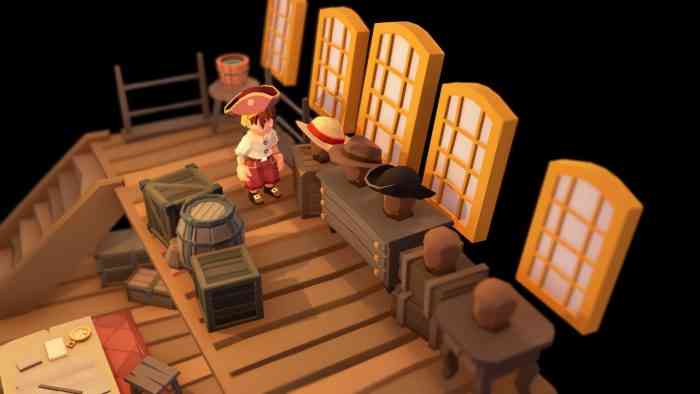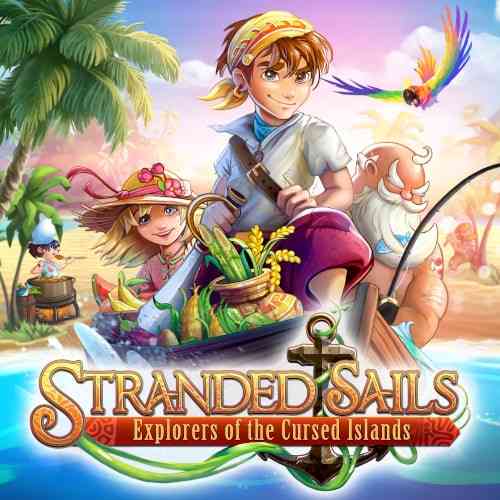Stranded Sails: Explorers of the Cursed Islands Review
Relaxed farming and simulation games have been a guilty pleasure of mine for almost as long as I can remember. Countless hours of my life have been spent idling in a crop field in Harvest Moon, Stardew Valley, My Time at Portia, and more. I’m a sucker for the genre and I’ll try out just about any new addition to it you can name, which is why I was initially stoked about Stranded Sails: Explorers of the Cursed Islands. Stranded Sails is a brand new, open-world castaway adventure with a focus on farming and discovery that maroons you and a crew of colorful characters on an island with a mysterious secret. While all of the elements seem to add up to a cute adventure that rewards exploration and satisfies the craving for a new addition to the farming genre, I found the experience to fall extremely flat in a glaring variety of ways.
A Farmer’s Life For Me
Stranded Sails starts you off on the docks of a city where your father and a group of crew members are waiting for you on a beautiful ship, ready to set sail on the high seas. Of course, your ship is torn asunder by a terrible storm, and you end up on an archipelago where you must set up a camp and search for your crew. You end up establishing a home base with a small plot of arable land and a source of freshwater close by, and it’s your job to grow crops, cook food, and explore the island for characters and clues.
This is pretty much all you do. For the first handful of hours in the game, the story revolves around finding the crew and building a house for every single one, all the while maintaining your little plot of crops. It wouldn’t be so bad of a premise if it weren’t for the extremely monotonous execution of these tasks. Stranded Sails uses an energy system to drive the game, meaning every action you perform uses up a chunk of energy and the only way to stay fueled is to eat food that you cook or go to sleep on the remains of the ship that’s nestled on the shore. As you will quickly learn should you pick up this game yourself, the energy system is the double-edged sword of Stranded Sails: on one side, it’s a ridiculously tedious mechanic that offers no real consequence if you drain all of it and die, and on the other it’s the one and only element of the game that actually gives a point to all of the farming and cooking you have to muscle through.

The basic mechanics of the game invite you to plant seeds, water them and wait for them to grow and then use the harvested crops to cook new recipes. There is also a resource crafting element for building things such as shelters and bridges. Both the workshop and the cooking station are located next to your plot, and the only way to discover new recipes for food is to endure the crazy system of throwing in a certain number of ingredients and blindly combining different plants until you guess the right combination. You will never be told what recipe you’re trying to create, nor will you be told what to combine. It’s up to you to try out every single way to mix and match carrots, potatoes, tomatoes and corn until you get the right answer. Each recipe has a corresponding energy value, meaning the more advanced recipes you uncover later in the game will grant a higher energy recovery boost that will allow you to explore for longer.
This is where Stranded Sails relies on its energy mechanic to add substance to the game. Without the energy system, there would be absolutely no point to farming or cooking at all, as the crafting system isn’t tiered the way it is in a game like Stardew Valley; where you always want to maximize what you’re farming in order to make money to expand your house, purchase more animals, upgrade tools, and more.
No Treasure Here
Stranded Sails doesn’t feel flawed so much as just plain cumbersome. The storyline is linear, though you do little more than fetch-quests and menial tasks for a lazy group of sailors. Everybody wants a house, which means lots of running around looking for trees to chop for you — but not too fast, because that’ll cost you energy. The default run speed of your character is basically between a walk and a jog, and sprinting will deplete you at a pretty strong rate. Never mind the devastating amount of energy it takes to chop down enough trees to craft anything, which is tedious in the beginning of the game because your inventory is so small and the low-grade food you cook at first is not very restorative. Should you drain all of your energy, you simply pass out and wake up again on the ship. No progress or inventory items are lost, and frankly, sometimes it’s a convenient method of fast traveling if you’re far out on the island and don’t feel like slowly trudging all the way back.

One shortcoming I found in the game is the complete lack of animals on the island. There’s one parrot flying around that plays a role in the story, but other than that, you won’t see lots of birds in the trees or squirrels in the forest. The farming component encompasses plants only, so you’ll never get to raise cows or chickens like you can in almost every other farming game. It’s a shame, because it would add a lot more charm to the wildlife of the island and a lot more fun and incentive to the gameplay.
Incentive is a buzzword that kept coming to mind during my time with Stranded Sails. It doesn’t feel like there’s almost any incentive to continue playing the game, even in the first couple hours. The story takes far too long to grip you, and the quests just flat out feel like work. Your original plot of land can be expanded over the course of the game, but it doesn’t even feel like there’s a reason to do this as the crops you can grow on your small plot are more than enough to feed you and your crew. Every action takes so long and uses so much energy that it’s also off-putting in a lot of ways, especially when it comes to venturing out on the island.
Island Relaxation
Stranded Sails does deserve credit where its due in some aspects. It wholly succeeds at being a peaceful and tranquil experience with its amazing sound design. The mesmerizing sound of waves cresting and breaking is always looping in the background, and the musical score is possibly the most beautiful part of the game. Different lullabies play as you wander around the island, and each song is catchy and lovable — it sort of reminded me of the original Zelda scores.

Artistically, the style is polygonal and cute, but the graphics suffered a bit in the Switch’s handheld mode. Though this is the perfect type of game for a portable console and it plays perfectly well on one, the game looked significantly better docked and on other consoles.
At its surface, Stranded Sails: Explorers of the Cursed Islands looks like an adorable and endearing addition to this genre, and though I so badly wanted to love it, I’d have difficulty recommending it to almost anyone other than young children. There is certainly a place in the gaming world for peaceful, low-pressure exploration and farming games, but unfortunately, I’m not convinced that Stranded Sails is one that belongs. The minute-to-minute gameplay is just not stimulating enough, the quests and actions are fairly mindless, and overall, there just isn’t enough reason to pick it up time and time again.
***Nintendo Switch code provided by the publisher.***
The Good
- Beautiful sound design and music
- Adorable art style
- Peaceful
The Bad
- Energy system makes everything tedious
- Quests are not stimulating
- Farming doesn’t feel rewarding

